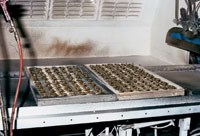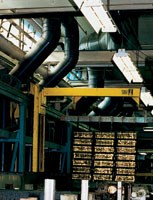Protecting and Enhancing Decorative Plated Componentry at Keeler Brass
Brass, copper, chromium, nickel, whatever the coating, Keeler Brass gives it a glossy, durable finish using an EPA-compliant lacquer...
Keeler Brass creates art. Evolving as ideas in the minds of designers and architects, the company designs unique cabinetry hardware and decorative accents for the wood and steel furniture markets. With more than 54,000 designs to date, and 2,100 finishes to enhance these designs, one would think that no two sets of kitchen cabinets or bedroom dresser would have the same componentry. Yet the company's Design Department is continually working with customers to develop new pieces of "art."
"Each designer wants his/her design to be different, unique," stated Bill Ellis, finishing manager. "We may have 400 standard finishes, but there are 1,700 variations on those finishes." These finishes help provide the individuality the designers and architects are looking for.
"We also have quite a large sampling business," said Mr. Ellis. "Sampling lots range anywhere from 5 or more pieces, and we do 15 to 50 sample orders each day." Keeler tries to run these sampling lots directly through the production process so that the customer can see a true of example of what will happen in actual production. "We try to duplicate the actual production process as much as possible," Mr. Ellis continued. "Once the customer agrees on a look it wants, we can reproduce it every time."
Keeler Brass designers hand draw the designs, working with the customers to create the exact effect they desire. Once the design is perfected on paper, a sculptor carves a three-dimensional version of it using clay, plastic or wood. These renditions are used to develop the final molds in which the castings are made. From the final molds, castings of spin-cast zinc, zinc diecast and sand-cast zinc and brass are formed at the company's on-site foundry. The company also creates pieces from stamped steel and brass on-site.
These creations from the stamping and diecasting areas are not quite as pretty as they looked in their original drawings. They are more than likely covered with oils and burrs that need to be removed. Vibratory finishing removes most of the burrs from the pieces. Oils and other soils are removed using ultrasonic aqueous cleaning and/or trichloroethylene degreasing.
Most of the parts at Keeler Brass go through the five-year-old completely contained degreasing system. "We bought the new degreaser five years ago when the new NESHAP was enacted," noted Mr. Ellis. "We did a year-and-a-half-long study at that time to see if we could switch to all aqueous cleaning. We could not find a system that was universal with all of our soils, part variety and substrates." The degreaser also helps with water spotting problems and rust. With steel substrates you can have rusting problems with an aqueous cleaner. Trichloroethylene degreasing eliminates this. Also, with brass products, it helps cut down on water spotting problems tremendously. Some antiqued brass parts are cleaned in the degreaser after finishing but prior to lacquering. The degreasing eliminates water spots or imperfections that might show through the clear lacquer.
So, how do you fit 400 standard decorative finishes into one finishing shop? Three floors, two random loading automated barrels lines, one random loading rack plating line, an automated electrocoating line, several paint lines (both automated and manual), numerous vibratory bowls, dip/spin coaters, polishing and buffing equipment.
With all the parts processed at Keeler, the lot sizes must be huge. Not so. Keeler has noticed that lot sizes are actually getting smaller. Mr. Ellis attributes this to Keeler's customers' use of just-in-time manufacturing, lower inventories and shorter lead times. Smaller lots range from 200-250 pieces. Also, many pieces are unique to one designer or furniture manufacturer, which does not need a tremendous number of pieces for its specially crafted furniture; hence a limited number of components are needed.
Whether it is a big or small lot, more parts are run on the cyanide brass barrel plating line than any other line in the finishing shop. "We looked into non-cyanide brass, but it is a different color," explained Mr. Ellis. "It is more green than what we get from the cyanide brass plating solution. In our business we want durability, of course, but our main interest is aesthetics. That is what the customers care about."
There are 7 rack/unrack stations for the rack line, which has the capability of plating copper, copper/nickel/chromium, copper/brass and various nickel finishes. After parts are racked, the racker programs one of the 55 operating sequence into the random loading system, and the parts are automatically taken to the line and plated with the correct decorative finish.
However, most parts simply do not run through the line, dry off and head for packaging and shipping. Many of these parts go on to receive specialty finishes that make them unique, one-of-a-kind designs. A variety of techniques are used to generate these specialized appearances. The highlighting process relieves the part and brings out some base metal. This oxidation is then removed using wet or dry vibratory finishing, tumbling with corncob media, polishing wheels, automatic belts or by hand. The parts are then degreased. What remains is a highlighted appearance.
Other finishes include painting the pieces and then hand wiping off the paint in certain areas while they are still wet, giving the parts a "distressed" look. All finishes receive a clear protective lacquer coating.
Keeler Brass recently switched to a new lacquer system from G.J. Nikolas & Co., Inc. "Keeler was in compliance with its HAPs and VOC regulations, but we wanted to be sure that we continued to comply for the future. There were also other reasons we decided to go with this lacquering system," noted Mr. Ellis. Keeler Brass liked the idea of preblended lacquers. Previously the company purchased a clear lacquer and a flat lacquer and would have to blend the two to get a semi-gloss. Considering that it runs three shifts, it could end up with three different gradations of semi-gloss. With the preblended lacquers, the gloss is uniform for all parts throughout every shift. "Just as everyone with a quality operation tries to reduce variation, we wanted to do that. Each operator would blend the lacquer his/her own way. Bringing the lacquer in at a consistent viscosity without any extra mixing really helped with consistency in the product. There is less variance in the final look," commented Mr. Ellis. "And lacquers are probably one of the more difficult finishes to deal with here at Keeler Brass because we have such a variety of decorative finishes that we need to coat with lacquer. Polished brass is probably one of the most difficult. You need a lacquering system with a broad application ability."
Lacquers are applied using dip/spin, electrostatic spray with micro bells, electrostatic spray using HVLP, automatic spray with fixed guns on a chain-on-edge system and hand spraying with HVLP. Also, each lacquer is cured differently. Some are air-dried, others are baked and some are given a small boost of heat to accelerate drying.
The lacquer that is applied using the mini electrostatic bell system can also be applied using a dip process. Parts are laid out on a belt that passes under the oscillating bells. The lacquer is EPA compliant, scratch resistant and chemical resistant. Although, the coating can be air-dried, Keeler provides some heated air to accelerate the drying process.
"We want the product to be durable and long lasting, but because it is an interior product, we are not as concerned about salt spray and humidity resistance as we would be if these products were going to be used outdoors," explained Mr. Ellis. "However, with this lacquer, the pieces withstand 60 hours salt spray and 100 hours humidity."
The fixed-gun automated spray system uses a different lacquer from the one used with the bell system. This lacquer is also EPA compliant. The difference in this lacquer is that it is allowed to flash off for 5-10 min before baking at 275F for 20-30 min.
The hand-held spray process also uses an EPA-compliant lacquer that is mar resistant and available in colors and toners to provide special effect finishes on the parts. Keeler applies these lacquers to the same thickness, spraying them at 40-50 psi. Parts air-dry for about 30 min; it is sometimes accelerated with force drying at 120-190F for 10-30 min.
Even with all the different lacquer formulations for a specific gloss material, part uniformity is achieved. Yet each individual piece carries with it its unique beautiful accents. In more than 100-year-old tradition of fine craftsmanship, Keeler Brass creates metal componentry that is as beautiful as it is functional. Because that is the work and the art of Keeler Brass.
Related Content
How to Maximize Nickel Plating Performance
The advantages of boric acid-free nickel plating include allowing manufacturers who utilize nickel plating to keep up the ever-changing regulatory policies and support sustainability efforts.
Read MoreAn Overview of Electroless Nickel Plating
By definition, electroless plating is metal deposition by a controlled chemical reaction.
Read MoreTroubleshooting Alkaline Zinc
One of the most common problems that can arise when plating with alkaline zinc is an imbalance of brightener in the solution. In this helpful Ask the Expert article, Chad Murphy of Columbia Chemical discusses how different zinc metal concentrations and brightener concentrations can impact efficiency.
Read MoreNanotechnology Start-up Develops Gold Plating Replacement
Ag-Nano System LLC introduces a new method of electroplating based on golden silver nanoparticles aimed at replacing gold plating used in electrical circuits.
Read MoreRead Next
Episode 45: An Interview with Chandler Mancuso, MacDermid Envio Solutions
Chandler Mancuso, technical director with MacDermid Envio discusses updating your wastewater treatment system and implementing materials recycling solutions to increase efficiencies, control costs and reduce environmental impact.
Read MoreEducation Bringing Cleaning to Machining
Debuting new speakers and cleaning technology content during this half-day workshop co-located with IMTS 2024.
Read MoreDelivering Increased Benefits to Greenhouse Films
Baystar's Borstar technology is helping customers deliver better, more reliable production methods to greenhouse agriculture.
Read More














.jpg;maxWidth=300;quality=90)










